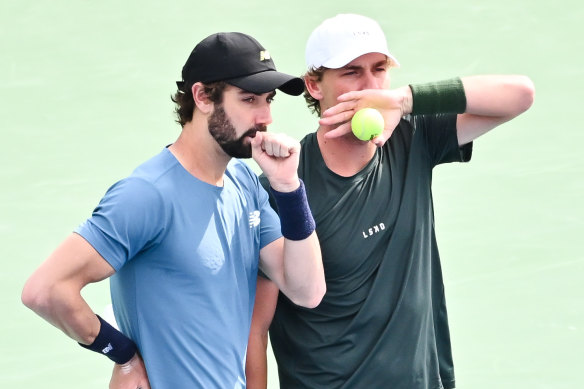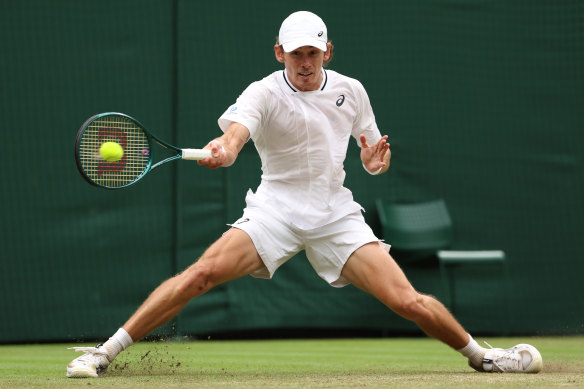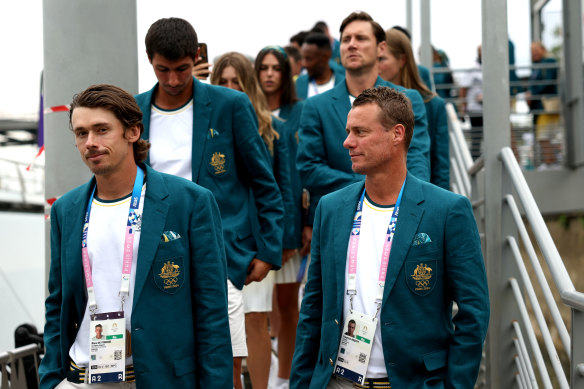By Marc McGowan
Australian tennis’ envious rankings milestone has crept up on everyone, even if Max Purcell insists it is “a long time coming”.
Ten Australian men – Alex de Minaur (No.10), Alexei Popyrin (28), Jordan Thompson (33), Rinky Hijikata (65), James Duckworth (70), Thanasi Kokkinakis (84), Chris O’Connell (86), Purcell (91), Aleks Vukic (94) and Adam Walton (96) – enter this year’s US Open ranked in the world’s top 100. That is even with 2022 Wimbledon runner-up Nick Kyrgios still sidelined.

Australians Jordan Thompson and Max Purcell are doubles teammates but also both in the world’s top 100 for singles.Credit: Getty Images
The last time this happened was the season-opening rankings in 1982, when Peter McNamara and Mark Edmondson – the last local men’s champion at the 1976 Australian Open – led the way for Australia.
Only France had as many top-100 men’s players in the past week, while the United States and Italy are one shy of Australia with nine each.
“There’s been no question that we’ve all had ability,” Purcell said.
“I think all of us are just finding different ways to manage the workload throughout a year and figuring out how to get the most out of ourselves. Obviously, Demon (de Minaur) getting stronger and stronger is helping us. I feel like we need to catch him a little bit.”
It is an eclectic Australian group, given some were highly touted juniors destined to be stars, whereas others, such as Vukic and Walton, were less acclaimed and instead chose the US college route.
Hijikata, who reached the last 16 at last year’s US Open, was a top-10 junior, but also went to college briefly before taking the leap.
Duckworth, O’Connell and Kokkinakis all endured significant injury challenges on their journey to elite company. The Aussie crew are not in New York just to make up the numbers either.
De Minaur, who has recovered from the hip injury that caused him to withdraw from Wimbledon, is hunting a third major quarter-final in a row. He is the country’s Davis Cup spearhead, spiritual leader and standard-setter on and off the court.

Alex de Minaur has made an impact at the majors so far this year.Credit: Getty Images
Popyrin is fresh from a breakthrough triumph at the Masters 1000 event at Montreal, while Thompson – only one spot off being seeded – is also an ATP singles champion this year.
There will be 12 Australian men in total in the US Open main draw thanks to emerging West Australian Tristan Schoolkate scoring a wildcard and South Australia’s Li Tu qualifying to continue his unlikely rise.
Throw in making the past two Davis Cup finals under Lleyton Hewitt, and Australia is a powerhouse in men’s tennis.
Hewitt, who was part of a golden era with fellow former world No.1 Patrick Rafter and Mark Philippoussis, believes Australian men’s tennis is “thriving” with a strong culture.
“The last three or four years, we’ve tried to put in place the right guys in Davis Cup teams, who have gone out there and led by example, and that’s been a major reason, I think [for the success],” Hewitt said.
“They’ve all been pushing each other on the ATP Tour through the year, getting career-high rankings, which is great, and obviously Alex [being] in the top 10 [means] they’ve had guys to look up to as well, and just see the training discipline some of these top guys have.
“Everyone thinks, ‘Well, if they’re doing it; why can’t I go out there and have those results as well?’.”
Walton’s maiden grand slam main draw victory at Wimbledon last month ensured Australia achieved the double-digit ATP Tour rankings feat, which they have maintained since.
He is the same age as de Minaur (25), but never went on any of the Tennis Australia overseas trips, so they only got to know each other since Walton graduated from the Challenger Tour.
“Usually, when we go to tournaments, before the event you will more than likely practise with the other Australians, and do stuff like go to dinner together,” Walton said.
“I just feel like that sort of support [is invaluable]. We’re playing cards at lunch, or just mingling around and talking to each other, and everyone’s in good spirits and bringing everyone up.”
There is a special bond between the Australian players, in part because they live a lonelier existence than many of their opponents.
Their big advantage is having a grand slam in their backyard that presents more developmental funding and opportunities via wildcards, but the downside is how far away Australia is from where most of the tournaments are played.
European and American rivals can fly home between tournament blocks, whereas their Australian peers routinely spend nine months on the road every year.
Missing home will never go away, but the increasing number of Australians at ATP Tour events means it is less of an issue.
“The camaraderie and culture between everyone is unbelievable,” Hijikata said.

Alex De Minaur (left), Alexei Popyrin and Lleyton Hewitt at the Olympics in Paris.Credit: Getty Images
“I’m one of the youngest at the moment, and I feel like everyone’s taken me under their wing, and I don’t think I would have been able to transition and be as comfortable without everyone’s guidance and help.
“It’s unreal having so many Aussies [on the tour] at the moment … and there are a lot, lot more guys coming up, so I’m excited to see what everyone can do.”
There are some epic games of cards – Hearts is the one of choice – with Hijikata, Thompson and Walton the regulars, but they have roped in Purcell before as well.
Purcell, a Wimbledon doubles champion, also keeps busy with harsh and humorous critiques of coffee at every international stop on his Instagram account.
The other competitive pastime the Australians share is golf, where Olympic gold medal-winning doubles player John Peers rules the roost, according to Popyrin.
“Peersy is a really good golfer,” Popyrin said. “But Demon’s quite good. Lleyton’s really good also, [whereas] I’m learning – I’m going through a few swing kinks that I need to figure out.”
Hewitt said there was a “little bit of unknown” about de Minaur, since he had not played singles since his career-best Wimbledon run last month, but was bullish about him if he could work his way into the tournament.
The dual grand slam champion also would not be surprised if Popyrin and Thompson did some damage at Flushing Meadows.
Popyrin, too, is confident the Australians will make their presence felt.
“Everybody, I think, is playing some unbelievable tennis,” he said.
“We’re all probably in the form of our life right now. Demon, Thommo, myself, ‘Vuk’ [Vukic], ‘Rinks’ [Hijikata], ‘Oaks’ [Chris O’Connell] – everybody. Australian tennis is going the right way.”
News, results and expert analysis from the weekend of sport sent every Monday. Sign up for our Sport newsletter.